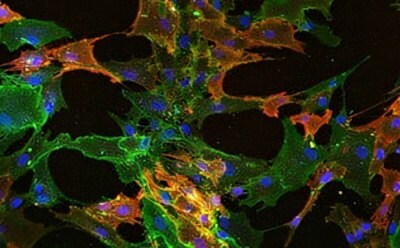幹細胞培養
関連技術資料
- FAQs and information about IPS Cells or induced pluripotent stem cells (iPSCs). Including what are IPS cells, learning stem cell basics, reprogramming methods, and iPS cell culture techniques.
- Mouse embryonic fibroblasts (MEFs) serve as a feeder layer for both mouse and human embryonic stem cells (ES cells) and induced pluripotent stem cells (iPSCs).
- We offer a large collection of cell culture media, supplements, bioactive small molecules, and growth factors used to control the cell fate of human iPSCs.
- Read types of stem cells including multipotent stem cells, Pluripotent stem cells and iPSCs and their applications in basic stem cell research, stem cell therapy and disease modelling
- This white paper illustrates the importance of three-dimensional (3D) cell culture in the production of pluripotent stem cell (PSC)-derived models of embryo development and differentiation. It contains a general overview of embryoid bodies (EBs) and a comparison between the various methods used for their generation.
- すべて表示 (29)
関連プロトコル
- Information about mesenchyme, specifically mesenchymal stem cell procotols. Step-by-step cell culture protocols for mesenchymal stem cell (MSC) isolation, expansion and differentiation.
- Step-by-step stem cell culture protocols for human induced pluripotent stem cells (iPSCs) including ips cell thawing, expanding, freezing and characterizing.
- Step-by-step culture protocols for neural stem cell culture including NSC isolation, expansion, differentiation and characterization.
- Stem Cell protocols for cryopreservation, thawing of cryopreserved stem cells and media preparation.
- Step-by-step hematopoietic stem cell culture protocols for isolation, expansion and differentiation of CD34+ hematopoietic progenitor cells including CFU assays. It can be cultured under defined conditions designed either to promote self-renewal and increase the number of primitive cells.
- すべて表示 (10)
技術資料・プロトコルの検索

多分化能を持つ幹細胞には、自己複製したり、特殊な組織特異的細胞型に分化したりすることのできる成体幹細胞が含まれます。例としては、さまざまな血球に分化する造血幹細胞(HSC)、骨芽細胞、筋細胞、軟骨細胞、脂肪細胞に分化する間葉系幹細胞(MSC)、ニューロン、アストロサイト、オリゴデンドロサイトに分化する神経幹細胞(NSC)があります。
多能性を持つ幹細胞は、あらゆる細胞系統に分化することができ、由来する組織に基づいて、胚性幹細胞(ESC)、周産期幹細胞、および人工多能性幹細胞(iPSC)に分類されます。ESCは胚に由来し、in vivo幹細胞培養で無期限に分裂する可能性があります。周産期幹細胞は、臍帯または胎盤の血液や組織に由来し、最も広く使用されている多能性幹細胞です。出生時の臍帯血バンクは、将来の合併症治療の選択肢としてますます受け入れられるようになっています。iPSCは、ESCの挙動を模倣するように再プログラミング(誘導)された成体細胞です。医療用途にiPSCを使用することの重要な利点として、細胞が患者自身の組織に由来するため、移植片拒絶反応を起こす可能性が低いことがあります。
幹細胞研究用途
幹細胞は、自己複製して成熟細胞型に分化するその能力ゆえに、基礎科学と臨床研究の成長著しい一分野を形成するようになっています。幹細胞の現時点での臨床応用には、神経疾患と循環器疾患、自己免疫疾患、がんの治療、創傷治癒、疾患モデリングと薬物スクリーニングなどが含まれます。CRISPRのような新たに発見された遺伝子編集技術は、幹細胞研究を発展させ、難病治療に大きな可能性を切り開くものとして期待されています。
幹細胞培養の基礎
幹細胞を研究室で増殖させるには、高品質の特殊な培地と専門的な培養技術が必要です。幹細胞の培養条件が最適でないと、幹細胞の望ましくない分化や細胞老化が起こりやすくなります。幹細胞の分化は、in vivoではさまざまな因子により誘導されますが、その一部はin vitroの培養幹細胞で再現することができます。一部の不死化幹細胞株は無限に培養することができるため、研究用途に適した幹細胞の種類を選択することが非常に重要です。
近年、幹細胞の研究分野では、CRISPRゲノム編集技術と3D細胞培養技術の登場による進歩がありました。iPSCからオルガノイドを生成する手法などの高度な細胞培養技術によって、より予測精度の高いin vitro「Disease-in-a-Dish」モデルを利用できるようになりました。
続きを確認するには、ログインするか、新規登録が必要です。
アカウントをお持ちではありませんか?